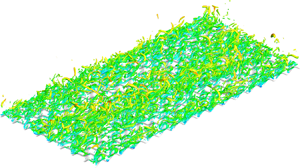Crossref Citations
This article has been cited by the following publications. This list is generated based on data provided by
Crossref.
Kuwata, Y.
2022.
Reynolds number dependence of turbulent heat transfer over irregular rough surfaces.
Physics of Fluids,
Vol. 34,
Issue. 4,
Flack, Karen
and
Chung, Daniel
2022.
Important Parameters for a Predictive Model ofksfor Zero Pressure Gradient Flows.
Zhang, Enwei
Wu, Wangxia
Liu, Qingquan
and
Wang, Xiaoliang
2022.
Effects of vortex formation and interaction on turbulent mass transfer over a two-dimensional wavy wall.
Physical Review Fluids,
Vol. 7,
Issue. 11,
Jelly, T.O.
Ramani, A.
Nugroho, B.
Hutchins, N.
and
Busse, A.
2022.
Impact of spanwise effective slope upon rough-wall turbulent channel flow.
Journal of Fluid Mechanics,
Vol. 951,
Issue. ,
Zhang, Enwei
Wang, Xiaoliang
and
Liu, Qingquan
2022.
Numerical investigation on the temporal and spatial statistical characteristics of turbulent mass transfer above a two-dimensional wavy wall.
International Journal of Heat and Mass Transfer,
Vol. 184,
Issue. ,
p.
122260.
Li, Shilong
Yang, Xiaolei
and
Lv, Yu
2022.
Predictive capability of the logarithmic law for roughness-modeled large-eddy simulation of turbulent channel flows with rough walls.
Physics of Fluids,
Vol. 34,
Issue. 8,
Ma, Guo-Zhen
Xu, Chun-Xiao
Sung, Hyung Jin
and
Huang, Wei-Xi
2022.
Scaling of rough-wall turbulence in a transitionally rough regime.
Physics of Fluids,
Vol. 34,
Issue. 3,
Flack, Karen A.
and
Chung, Daniel
2022.
Important Parameters for a Predictive Model of ks for Zero-Pressure-Gradient Flows.
AIAA Journal,
Vol. 60,
Issue. 10,
p.
5923.
Li, Shilong
Zhou, Zhideng
Chen, Danyang
Yuan, Xianxu
Guo, Qilong
and
Yang, Xiaolei
2023.
Effects of Wall Topology on Statistics of Cube-Roughened Wall Turbulence.
Boundary-Layer Meteorology,
Vol. 186,
Issue. 2,
p.
305.
Zhang, Enwei
Wang, Zhan
Wu, Wangxia
Wang, Xiaoliang
and
Liu, Qingquan
2023.
Secondary flow and streamwise vortices in three-dimensional staggered wavy-wall turbulence.
Flow,
Vol. 3,
Issue. ,
Yu, Ming
Zhou, Qingqing
Su, Hongmin
Guo, Qilong
and
Yuan, Xianxu
2023.
Influences of wall disturbances on coherent structures in supersonic turbulent boundary layers.
Acta Mechanica Sinica,
Vol. 39,
Issue. 12,
Massey, J.M.O.
Ganapathisubramani, B.
and
Weymouth, G.D.
2023.
A systematic investigation into the effect of roughness on self-propelled swimming plates.
Journal of Fluid Mechanics,
Vol. 971,
Issue. ,
Xu, Fan
Su, Jinghong
Lan, Bin
Zhao, Peng
He, Yurong
Sun, Chao
and
Wang, Junwu
2023.
Direct numerical simulation of Taylor–Couette flow with vertical asymmetric rough walls.
Journal of Fluid Mechanics,
Vol. 975,
Issue. ,
Yu, Ming
Zhou, QingQing
Dong, SiWei
Yuan, XianXu
and
Xu, ChunXiao
2023.
Compressibility effects in supersonic and hypersonic turbulent boundary layers subject to wall disturbances.
Journal of Fluid Mechanics,
Vol. 972,
Issue. ,
Zhong, Kevin
Hutchins, Nicholas
and
Chung, Daniel
2023.
Heat-transfer scaling at moderate Prandtl numbers in the fully rough regime.
Journal of Fluid Mechanics,
Vol. 959,
Issue. ,
Ma, Guo-Zhen
Xu, Chun-Xiao
Sung, Hyung Jin
and
Huang, Wei-Xi
2023.
Outer-layer similarity and energy transfer in a rough-wall turbulent channel flow.
Journal of Fluid Mechanics,
Vol. 968,
Issue. ,
Yu, Ming
Liu, PengXin
Tang, ZhiGong
Yuan, XianXu
and
Xu, ChunXiao
2023.
Effects of wall disturbances on the statistics of supersonic turbulent boundary layers.
Physics of Fluids,
Vol. 35,
Issue. 2,
Bilgin, Eylul
and
Cantwell, Brian J.
2023.
Application of the Universal Velocity Profile to rough-wall pipe flow.
Physics of Fluids,
Vol. 35,
Issue. 5,
Chan, C.I.
and
Chin, R.C.
2023.
Turbulent boundary layer flow over a three-dimensional sinusoidal surface.
Journal of Fluid Mechanics,
Vol. 975,
Issue. ,
Kuwata, Y.
Yamamoto, Y.
Tabata, S.
and
Suga, K.
2023.
Scaling of the roughness effects in turbulent flows over systematically-varied irregular rough surfaces.
International Journal of Heat and Fluid Flow,
Vol. 101,
Issue. ,
p.
109130.

 ${{k}^{+}}$ and the roughness steepness S, the results for three groups of cases are considered and compared with those for flat-wall turbulence. The results show that the mean velocity and Reynolds stresses are highly dependent on both
${{k}^{+}}$ and the roughness steepness S, the results for three groups of cases are considered and compared with those for flat-wall turbulence. The results show that the mean velocity and Reynolds stresses are highly dependent on both  ${{k}^{+}}$ and S. To describe these specific relationships, we define a coupling scale
${{k}^{+}}$ and S. To describe these specific relationships, we define a coupling scale  ${{k}^{+}} S$. With this coupling scale, all the simulated data for the roughness function (
${{k}^{+}} S$. With this coupling scale, all the simulated data for the roughness function ( ${\rm \Delta} {{U}^{+}}$), the ratio of the pressure drag to the total wall resistance (
${\rm \Delta} {{U}^{+}}$), the ratio of the pressure drag to the total wall resistance ( ${{\gamma }_{p}}$), the normalized bulk mean velocity (
${{\gamma }_{p}}$), the normalized bulk mean velocity ( $U_{b}^{+}$) and the peak of the streamwise turbulent velocity fluctuations (
$U_{b}^{+}$) and the peak of the streamwise turbulent velocity fluctuations ( $\overline {u_{p}^{\prime +}}$) collapse onto single curves, which shows that there is a strong direct correlation between them, i.e.
$\overline {u_{p}^{\prime +}}$) collapse onto single curves, which shows that there is a strong direct correlation between them, i.e.  ${\rm \Delta} U^{+}, \gamma _{p}, U_{b}^{+}, \overline {u_{p}^{\prime +}} \propto f(k^{+} S)$. Furthermore, a model for the prediction of wall resistance based on the roughness function can be established by defining a drag increasing ratio (DI). Accordingly, the wall resistance coefficient
${\rm \Delta} U^{+}, \gamma _{p}, U_{b}^{+}, \overline {u_{p}^{\prime +}} \propto f(k^{+} S)$. Furthermore, a model for the prediction of wall resistance based on the roughness function can be established by defining a drag increasing ratio (DI). Accordingly, the wall resistance coefficient  ${{C}_{f}}$ can be estimated directly from
${{C}_{f}}$ can be estimated directly from  ${{k}^{+}}S$ of a given rough surface. These results suggest that this coupling scale provides a useful alternative to the equivalent sand grain roughness
${{k}^{+}}S$ of a given rough surface. These results suggest that this coupling scale provides a useful alternative to the equivalent sand grain roughness  ${{k}_{s}}$.
${{k}_{s}}$.